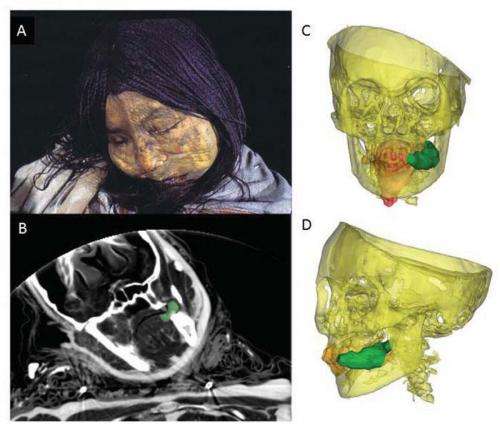July 30, 2013 report
New study shows frozen mummy Inca children given coca and alcohol before sacrifice

(Phys.org) —A new study conducted by an international team of experts has resulted in evidence showing that three Inca children sacrificed approximately 500 years ago ingested coca and alcohol in the months leading up to their deaths. In their paper published in the Proceedings of the National Academy of Sciences, the team describes how they analyzed hair samples to discern what sorts of drugs the children may have been exposed to before sacrifice.
The three children—a boy and girl each about age 4 or 5 and a girl aged 13—were found entombed near the summit of Llullaillaco volcano in Argentina in 1999. The bodies of all three of the children were in remarkably good condition due to the very low temperatures. Because of the location of their entombment and artifacts found on and around them, scientists have suspected that all three had been sacrificed as part of a ritual. In 2007, analysis of hair samples revealed the children's diet had changed radically over the months prior to their deaths—instead of mainly eating vegetables such as potatoes, the children had been consuming maize and even meat, likely from a llama. In this new study, it appears the children were also given a type of beer called chicha made from maize and coca (the source of modern cocaine).
Historians have believed for years that Inca children were sacrificed, partly out of ritual, and partly as a means of quelling dissent. Stories told to Spanish explorers often mentioned children being killed as part of sacrificial rites. This new study now offers scientific evidence to back up those stories.
As hair grows, evidence of what has been consumed grows with it, providing researchers a timeline of sorts. By analyzing hair samples from the follicles to the tips, researchers can trace a period of time that offers a glimpse of the lifestyle of the person from whom it was taken. In this case, it appears the older girl, known as the Maiden, lived a simple life until approximately a year before her death. From then on, it appears she was fed well and given large amounts of coca and chicha to prepare her for her sacrifice. A large wad of coca was even found in her mouth suggesting she may have been unconscious before she died. The younger children were also given a richer diet and fed coca and chicha during the months leading up to their sacrifice, but not to the degree of the Maiden—this was due, the researchers believe, to their status as attendants to the Maiden.
More information: Archaeological, radiological, and biological evidence offer insight into Inca child sacrifice, PNAS, Published online before print July 29, 2013, doi: 10.1073/pnas.1305117110
Abstract
Examination of three frozen bodies, a 13-y-old girl and a girl and boy aged 4 to 5 y, separately entombed near the Andean summit of Volcán Llullaillaco, Argentina, sheds new light on human sacrifice as a central part of the Imperial Inca capacocha rite, described by chroniclers writing after the Spanish conquest. The high-resolution diachronic data presented here, obtained directly from scalp hair, implies escalating coca and alcohol ingestion in the lead-up to death. These data, combined with archaeological and radiological evidence, deepen our understanding of the circumstances and context of final placement on the mountain top. We argue that the individuals were treated differently according to their age, status, and ritual role. Finally, we relate our findings to questions of consent, coercion, and/or compliance, and the controversial issues of ideological justification and strategies of social control and political legitimation pursued by the expansionist Inca state before European contact.
Journal information: Proceedings of the National Academy of Sciences
© 2013 Phys.org














